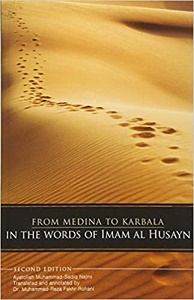From Medina to Karbala: In the Words of Imam Al Husayn
 | |
| Author | Ayatollah Muhammad-Sadiq Najmi |
|---|---|
| Language | English |
| Published | 2014 |
| Publisher | Sun Behind the Cloud Publications |
| Pages | 324 |
The book From Medina to Karbala: In the Words of Imam Al Husayn is a complete collection of Imam al-Husayn’s discourse, both oral and written.
About the author[edit | edit source]
The late Ayatollah Muhammad-Sadiq Najmi, born in 1315 Sh/ 1936, started his education when he was at the age of eight. He was both a prolific scholar and a social activist. His meeting with the late Ayatollah Allama ‘Abd al-Husayn Amini, the author ofal-Ghadir, in the village of Sharafkhaneh near the lake Urumiyeh, northwest Iran in the summer of 1350 Sh/ 1971, proved very insightful and full of inspiration. The late Ayatollah Najmi visited other countries for research purposes. He visited great libraries in Damascus, Syria; Istanbul, Turkey; and Mumbai, Lucknow, and Benares, India. In 1380 Sh/ 2002, the late Ayatollah Najmi decided to leave his posts and responsibilities to come back to Qom. In Qom he continued his scholastic pursuit for over ten years. During these years, he saw some of his works, including the present book, translated into several languages. He breathed his last on 25 Shahrivar 1390/ 16 September 2011 and was buried at Qom.
About the book[edit | edit source]
This book published in Sun Behind the Cloud Publications Ltd; 2nd edition (January 1, 2014), has 324 pages and best sellers rank of 1,651,225 in Books. It was written in Arabic language by Ayatollah Muhammad-Sadiq Najmi and translated to English by Dr Muhammad-Reza Fakhr-Rohani.
This book is an excellent step by step journey of Imam Hussain to Karbala and all the sermons he delivered on the way presented with expert analysis, and gives insight into the character and conduct of Imam Hussain and the martyrs of Karbala. It’s not just for Muslims but for anyone who believes in God.
Abstract of chapters[edit | edit source]
Part One: From Medina to Mecca[edit | edit source]
At the beginning of the chapter, we have Imam al-Husayn’s standpoint on the issue of pledging allegiance with Yazld and not recognizing his rule. Then the author examines two kinds of the Imams’ struggles: covertly and overtly according to Imam al-Husayn’s discourse in response to Marwan b. al-Hakam. Then before leaving Medina, Imam al-Husayn visited the tomb of his grandfather, Prophet Muhammad and there he outlined his future cause and the significance of his movement. He expressed his readiness for martyrdom, while stressing on his complaint against the Umayyad rulers.
Part Two: From Mecca to Karbala[edit | edit source]
This part examines Divine Will view. It starts with this issue that Imam al-Husayn had a revelatory dream in which the Holy Prophet told him to set out to Iraq because it was the Divine Will to find him slain. Divine Knowledge and anticipation inform of a reality dependent on the expression of the free will of a person in the future. This Divine Knowledge is not unique to Imam al-Husayn. Rather, it encompasses the cases of all prophets and holy people who would voluntarily perform their duties and would of course be capable of undertaking such tasks.
In summary, Imam al-Husayn was free in his movement. He was capable of abandoning his way at any moment, and to put an end to his revolution. However, he did not, for he was the leader and Imam, hence he was a role model for the entire world.
At the end of this part the author concludes that if an uprising, a revolution, killing, and being killed are conducted in the Right Path, one must not be scared of death. This is yet another lesson the school of Imam al-Husayn taught not only his son but to all his followers.
Part Three: In Karbala[edit | edit source]
As soon as Imam Hussein reached the region of Naynawa, Zuhair bin Zuhair suggested to him that it will be easier to fight that small number of enemy soldiers Instead of confronting the huge army that is coming soon. In response to this suggestion, Imam Hussein said to Zuhair that he would not start fighting them and suggested al-Hurr go further and find a better place to camp. They continued their way until they reached the region of Karbala. Imam al-Husayn was ready to sacrifice his life and the lives of his family members and have the survivors of his family members held as captives, all in support of Islam and the Qur’an, to invite people to do good, and in opposition to the long-established enemy of Islam, the Umayyad rulers.
In this part, Imam al-Husayn expressed the reality of this world and the Hereafter in a short and simple sentence in a letter to his step-brother Muhammad b. al-Hanaflyyah and his relatives. Hence, he provided them with his advice and direction. Simultaneously, he showed the world and all religious leaders the way and outlook they should undertake to direct people.
Imam al-Husayn at the end of this part, gives a compact lesson in Islamic basic articles of faith and particularly in Islamic monotheism. He had exercised all he could do to sincerely sacrifice what he had in the cause of Allah.